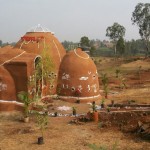Six years ago I had been to the village of Udgaon to have a look at the brickyards on the river bank. There I came across two kids in a family of migrant labor employed at the brick kiln. There I met Krishna of 6 years and his younger brother. Upon asking if they were willing to come with me to join a regular school, they readily agreed. The mother who was squatting nearby picking lice from the matted hair of a small girl consented to allow them to be taken along. How about their father? Will he too agree with the proposal? “Don’t worry about that. I will take care,” said the mother. So, Krishna and his brother Deva arrived at our school and they were duly enrolled. The Rector, Sunita took charge of them. First they were given a thorough bath with soap and warm water, and a set of fresh clothes. Sunita told her two daughters to take the two brothers along and play with them. The new comers shed their shyness and became a part of the play group.
Many of the new entrants at AVANI have no schooling background. First few years of their lives in the shanties are frittered away in animal abandon. They just grow like wild plants without culturation of any kind. It becomes necessary to study each child and for that a rapport needs to be established between them and our activists. Drawing and use of color is a good medium to help enter the mind of the child. Krishna was asked to draw a picture of his house. He sketched his makeshift shelter showing the mother cooking by the side of the firewood stove and the father just idling away, squatting at the entrance. Father’s figure was well drawn, but for one peculiarity. He was shown without both of his ears. When he showed the sketch to me I was struck by the absence of the father’s ears. I thought he is without the earlobes, poor fellow! A kind of a genetic defect, and instinctively looked at Krishna’s ears. I found them properly in place. I asked Krishna, does your father have no earlobes. “No, madam he doesn’t listen to what I say. We tell him not to drink so much but he doesn’t give up his addiction. He treats us violently, beats my mother and quarrels with her if asked for money to buy provisions. Then, why should I draw the ears on his head?”
Through the picture Krishna registered his vehement protest. I was surprised and did not know what to say. Krishna revealed the tragedy of his existence through that sketch and gave us an instant insight into his inner world. He gave me a new clue to peep into the emotional landscape of the children. The need for tenderness and sensitivity to treat with the children was brought home to me by this one eloquent gesture.
Our untiring work with Krishna will persuade him, I hope to look at us as we are, and represent as we are. We must ensure that when Krishna attains manhood and when he would look back he will surely draw the portraits of our activists with eyes of empathy and ears sensitive to each word of his, and of those like him!
Free English rendering : Arun Chavan
Original Marathi by : Anuradha Bhosale
Anuradha Bhosale graduated from the Tata Institute for Social Work in Mumbai and worked as an apprentice to Arun Chavan at Verala Development Society. After understanding the needs of the area she branched out on her own creating a small organization called AVANI which is a Marathi language acronym for Clothes, Food and Home for the poor children.
Arun Chavan was a professor of English Literature at Kolhapur University when he saw the poverty and destitution that surrounded him. He decided to give up his job and devote his life to working for the poor. He founded the Verala Development Society and has been working for the past 40 years to bring about a socio-economic change in the area.







Speak Your Mind